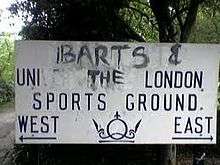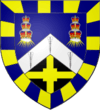St Bartholomew's and The Royal London Hospitals F.C.
 | |
| Full name | St Bartholomew's and The Royal London Hospitals Football Club |
|---|---|
| Nickname(s) | SBLHFC |
| Founded |
1996 through merger of two older sides Constituent elements: The London Hospital Medical College FC St. Bartholomew's Hospital Medical College FC |
| Ground | Perry Street |
| Capacity | 500 |
| Coach |
Joseph Sutton Mark Stacey |
| League | BUCS 4B |
| 2012/13 | 3rd |
| Website | Club website |
St Bartholomew's and The Royal London Hospitals FC ("SBLHFC") are the football club of Barts and The London School of Medicine and Dentistry, having been formed from the merger of two formerly distinct hospital football clubs each with a long history.
History
Football at St Bartholomew's Hospital[1]
An association football club was formed at St Bartholomew’s Hospital Medical College in 1879, the initiative coming in response to the start of inter-hospital competitions.
Until 1892 the various Athletic Clubs were separately maintained by the members of the individual clubs, but in 1892 it was finally decided that a fixed subscription should be paid by all students, and should be collected and administered by the School authorities. An entrance fee of five guineas entitled students to life membership of the Abernethian Society, Athletic, Boxing, Boating, Cricket, Lawn Tennis, Rugby, Swimming and Association Football Clubs which led to the acquisition of a sports ground by the College Committee at Winchmore Hill for £8,000 and a pavilion was erected and suitable pitches and tennis courts were laid out. The ground was taken over by the Amalgated Clubs in 1895. Prior to the acquisition of the sports ground at Winchmore Hill, the club played their home games at the Spotted Dog ground at Upton Lane.[2]
Around 1935, the students expressed the wish that the College would provide them with larger playing fields than those then in use at Winchmore Hill, as these were no longer adequate to meet the needs of the large number of students at the College. It was proposed, therefore, that an attempt be made to find a new ground, which would be large enough to cater for the student’s sporting requirements, and in 1937 the College purchased a new site at Foxbury, Chislehurst in Kent (now South London).
The new sports ground in Chislehurst was bought to take into account the increased popularity of sport as part of a wider fitness craze and the growth of sporting societies at St Bartholomew’s. Money was borrowed to build a pavilion and the student union was charged a higher rent. In June 1938 the pavilion was completed, and after the grounds had been leveled and returfed, three rugby pitches, and a football and hockey pitch were opened. Local residents were invited to the opening ceremony in an effort to ‘foster association’ with the hope of securing donations. Other sports facilities followed.
The successes of the Association Football Club in the United Hospitals Challenge Cup, the London Senior Cup and FA Cup attracted national attention and raised the profile of the college; notable early results include reaching the final of the London Senior Cup in the 1890-91 season, beating Millwall in the semi-final, only to be beaten 6-0 by Royal Arsenal at the Oval, the predecessors of the modern day Arsenal FC [3] and reaching the 2nd round of the FA Cup in the 1881/82 season after eliminating 5 times winners Wanderers FC in the 1st round, albeit via walkover.[4]
The site of the Medical College of St Bartholomew's at Charterhouse Square can also claim to be the birthplace of association football and Charterhouse football is regarded as a major influence in the development of the global game. Students at Charterhouse played football within the cloisters of the old Carthusian monastery and as space was limited the players depended on dribbling skills. Significantly, members of the football club at Charterhouse School at the Charterhouse Square site attended the original meeting of the Football Association in 1863 when it was decided by a group of interested teams to limit handling and hacking and to develop the art of football and St Bartholomew's Hospital were amongst their first opponents, visiting them as early as 1856.[5][6]
Football at The London Hospital[7]
Whilst football had been played at The London for many years previously, in 1893, for the first time, the students of The London had their own sports ground at Lower Edmonton which had been leased by the Clubs Union which itself had been founded in the same year. The College then later moved their sports ground to Hale End in Walthamstow which continued to be used and improved including the building of a new and better pavilion following its destruction by fire one night in 1956 until the merger and its later sale in 2000.
1995 onwards - post-merger
The teams from Royal London Hospital and St Bartholomew's Hospital merged in 1995 following the union of St Bartholomew's Hospital Medical College and the London Hospital Medical College with Queen Mary and Westfield College, now known as Queen Mary, University of London to form St Bartholomew's and the Royal London School of Medicine and Dentistry. Likewise, St Bartholomew's and The Royal London Hospitals FC was formed and have since played at the previous ground of St Bartholomew's Hospital Medical College, Chislehurst following the forced sale of the previous ground of The London Hospital Medical College at Hale End by Queen Mary.
Team colours
The current colours are based on the colours of St Bartholomew's Hospital, black and white. The hospital's black and white shield has been the badge of St Bartholomew’s Hospital for more than 500 years; it was the Coat of Arms used by John Wakering, the Master of the Hospital from 1423 to 1462.[8]
Competition
The club currently has five teams who compete in the University of London (ULU) league and cups, the British University Sports Association (BUSA) league and the National Association of Medical Schools tournament. In addition, the 1st team compete in the UH Challenge Cup, the 2nd team in the UH Reserves Cup and the 3rd - 5th teams in the UH Vase with the other London Medical Schools, Royal Free, University College and Middlesex Medical Students FC, Imperial Medics FC, Kings College School of Medicine FC & St. George’s Hospital Medical School FC. The Challenge Cup has been won by St Bartholomew's Medical College FC on 12 occasions (the last in 1947) and by The London Hospital Medical College FC 16 times (the last in 1992). The most recent success was winning the UH Challenge Cup in 2008, beating RUMS FC 2-0.
- St Bartholomew's Medical College FC UH Challenge Cup Winners: 1889, 1890, 1892, 1893, 1895, 1896, 1911, 1922, 1930, 1947
- The London Hospital Medical College FC UH Challenge Cup Winners: 1887, 1898, 1899, 1905, 1956, 1957, 1958, 1963, 1967, 1971, 1972, 1973,1974,1986, 1987, 1992
- St Bartholomew's and The Royal London Hospital's FC UH Challenge Cup Winners: 2006, 2008, 2015
Since the merger of St Bartholomew's Medical College and The London Hospital Medical College with Queen Mary, University of London in 1996 the football club has also participated in the Merger Cup.
Chislehurst

St Bartholomew's and The Royal London Hospitals FC play their home games on the east side of the Chislehurst site, the old ground of St Bartholomew's Hospital Medical College bought by the college in 1937. Current facilities include three football pitches, two rugby pitches, a cricket pitch and a grass tennis court. During the second world war the sports ground at Chislehurst was taken over by the Army and trenches were dug across the ground to prevent the landing of aeroplanes, but some pitches were usable and continued to be used.
References
- ↑ Waddington, Keir (2003). Medication Education at St Bartholomew's Hospital 1123-1995. The Boydell Press. ISBN 0 85115 919 2.
- ↑ "CHAPTER ONE: ORIGINS" (pdf). Retrieved 27 July 2012.
- ↑ "125 years of Arsenal history". Archived from the original on 23 September 2015. Retrieved 4 May 2012.
- ↑ "The FA Cup - Results". Retrieved 4 May 2012.
- ↑ "History of Association Football". Retrieved 4 May 2012.
- ↑ Harvey, Adrian (2005). Football: The First Hundred Years : the Untold Story. Routledge. ISBN 0415350190.
- ↑ Ellis, Sir John (1987). LHMC 1785-1985 The story of the London Hospital Medical College England's first Medical School.
- ↑ "Badges". Retrieved 4 May 2012.
